
24 minute read
Elementary School Remote Learning
Remote Teaching and Learning
Chapel staff uses researched-based instructional strategies to support student learning. We strive to provide developmentally appropriate practices to all our students. This means that special attention is placed on individualizing and differentiating instruction to meet each student where his/her development is in each area.
Synchronous Activities
Synchronous learning is the kind of learning that happens in real time. This means that students, their classmates, and their teacher will interact through video conferencing on “Zoom” and/or “Google Meets”.
Asynchronous Activities
Asynchronous learning happens within each class schedule. Teachers will provide materials for reading, presentations for viewing, assignments for completing, and projects for assessment. Students have the ability to access and satisfy these requirements within each day. Methods of asynchronous learning include video content, virtual libraries, and posted assignments.
Remote Learning 100% of the student population is online
Remote learning is fully digital. Teaching is delivered through digital means, such as learning platforms, videos, shared documents, synchronous and asynchronous activities, and others.
Hybrid Learning Stage 1 - 35% of the student population and Stage 2 - 70% of the student population Some students are on campus and some students are at home
Hybrid learning is what happens when part of the school experience is online, and part of the experience is on campus. A reduced number of students are on campus and follow a modified schedule, and observe enhanced health and safety precautions that include physical distancing. The remaining students continue learning from home with some synchronous and asynchronous learning.
This model allows students to be on campus for a full day, focuses on core classes, allows teachers to follow best pedagogical practices, enables intervention and enrichment, provides an equitable learning environment, and aligns with best practices from international schools worldwide.
The presence of students on campus is not mandatory, as long as students complete their tasks online.
During hybrid learning on the elementary school campus:
All students are required to wash and sanitize their hands frequently; Each veranda has a sink and each classroom has a hand sanitizer dispenser; Automatic, no-touch hand sanitizer dispensers are also installed in all hallways and in the cafeteria; Conventional water fountains, which risk possible mouth contact, are turned off and only automatic dispensers to fill water bottles are used; All elementary school students are required to wear face masks which will be changed every two hours. Each classroom has a face mask bin where students and teachers will safely discard their used masks; Classroom seating is reconfigured to ensure appropriate physical distancing and polycarbonate partition shields installed on desks and tables; Specials teachers, observing strict sanitation protocols, go to the different classrooms instead of students rotating from space to space; Materials are no longer shared. Parents are asked to provide students with individual pencil cases for their own exclusive use. Individual kits with materials such as counters, manipulatives, a whiteboard marker, flannel eraser cloths and more are provided to each student by the school and are used by only that student throughout the semester; The use of backpacks with wheels are suspended during the pandemic and all students must have regular backpacks which come and go from home everyday; In lower elementary school students will no longer brush their teeth after lunch; We will maximize opportunities for classes to take place outside with outdoor learning and activities Each classroom has a veranda and all hallways have a grass lawn. These areas will be used accordingly when the weather permits; Beyond the above all health protocols recommended by the government and health officials will be strictly followed throughout the school day; A comprehensive re-entry plan with detailed information about procedures and protocols will be shared with families in advance of initiating Hybrid Learning at Chapel School.
In Elementary School, in accordance with the 35% (Phase 1) or 70% (Phase 2) of the student population criteria, students will rotate between classes on campus and remote learning. Students on campus will follow the same assignments as students online. Additionally, when students are on campus teachers will prepare them for the next day of remote learning by reviewing assignments and equipping students with strategies to be more independent during the next day at home. Students at home will have some synchronous and asynchronous activities with teachers.
Students in remote learning will continue to have synchronous activities such as their live Morning and Afternoon Meeting, and a Portuguese class. Additionally, specialist teachers will continue to post assignments and also have live sessions which will be communicated in advance through the online platforms. Class assistants will be online during the school day for office hours and consultation with students. They will be able to guide and support students’ learning online.
Placement of Students
Placement of students into classrooms is a complex process. Chapel staff takes into consideration the development of the whole child in order to promote balanced classrooms. During this process,
Chapel staff studies and observes the academic level, social, behavioral and emotional needs, nationality, primary language, and other factors to create equitable classrooms. Students are placed in groups in which they will continue to build-on their social-emotional competencies and will be academically challenged each day. Chapel is committed to reviewing placement closely with students’ best interests in mind and aiming at the best learning environment for their development.
At Chapel parent requests for teachers and/or friends are not accepted.
1st, 2nd, 3rd, and 6th Grade
On Mondays, all students in these grade levels will remain at home and follow remote learning. On this day the classroom and specialist teachers will be online for live classes, office hours, and consultation with students.
Beginning on Tuesday and until Friday students in these grade levels will begin a rotation schedule. A reduced number of students (from each classroom) will come to school for classes on campus on alternate days. Other students will remain at home and follow the remote learning schedule for that day.
In Elementary School, we will follow a Week 1 and Week 2 rotation schedule. Each class population will be divided into groups, the white, and the blue group.
Week 1
The white group comes to school on Tuesdays and Thursdays, and the blue group on Wednesdays and Fridays.
Week 2
The white group comes to school on Wednesdays and Fridays, and the blue group on Tuesdays and Thursdays.
4th and 5th Grade
On Mondays, all 4th and 5th grade students will come to campus for classes and will be grouped into different classrooms to ensure appropriate physical distancing. For these grade levels, we will have a modified schedule on Monday that focuses on Core subjects and a specialist class (for example, English Language Arts, Portuguese, Math, and BSS). On this day, teachers will also prepare students for the assignments that they will need to complete during the week at home. On all other days of the week, the classroom and specialist teachers will be online for live classes, office hours, and consultation with students.
The Elementary School Office will send a rotation calendar to families in advance and prior to the reopening of campus. Please see below what the schedule will look like in Phase 1.
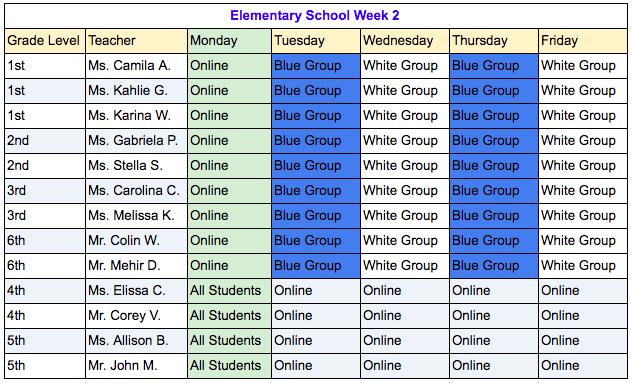

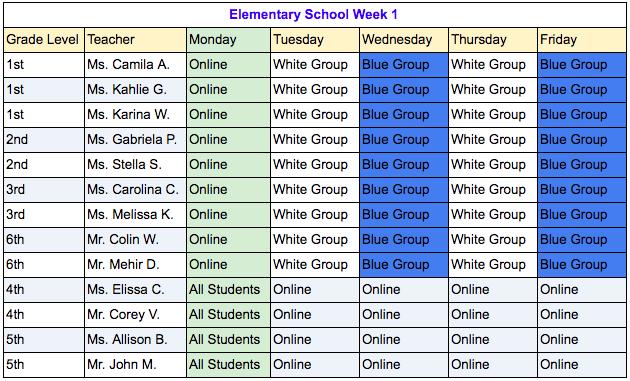
1st Grade
Students will come to school every day (Monday through Friday) and will be grouped into different classrooms to ensure social distancing. Students will follow a regular class schedule throughout the week, which includes both Core subjects and specialists’ classes. First grade students will be on campus every day for their classes.
2nd, 3rd, 4th, 5th, and 6th Grade
Students in these grade levels will begin a rotation schedule on Monday and until Friday. A reduced number of students (from each classroom) will come to school for classes on campus on alternate days. Other students will remain at home and follow the remote learning schedule for that day.
In Elementary School, we will follow a Week 1 and Week 2 rotation schedule. Each class population will be divided into groups, the white, and the blue group.
Week 1
The white group comes to school on Tuesdays and Thursdays, and the blue group on Mondays, Wednesdays, and Fridays.
Week 2
The white group comes to school on Mondays, Wednesdays, and Fridays, and the blue group on Tuesdays and Thursdays.
The Elementary School Office will send a rotation calendar to families in advance. Please see below what the schedule will look like in Phase 2.

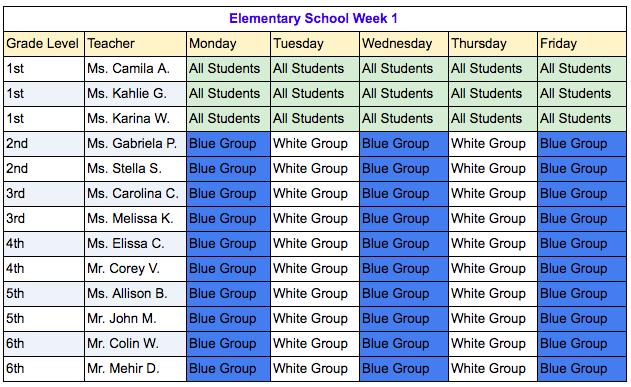

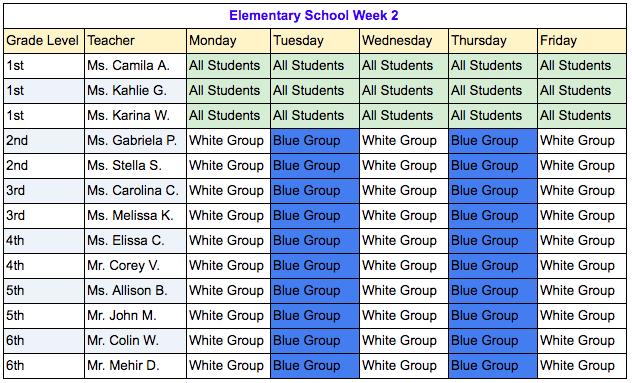
All Elementary School students are on campus for classes every day (Monday through Friday).
The three phases and plan above are subject to public policies. This plan may be reviewed and modified according to changes mandated by the government of the State of São Paulo.
Online Learning Tools
Google Classroom
Beginning in 3rd Grade, teachers communicate with students and post class assignments announcements through Google Classroom. Google Classroom streamlines assignments, boosts collaboration, promotes communication, and integrates with Google Suite. Through this online platform, teachers create their virtual classes, distribute assignments, post announcements, send feedback to students, and these are a few of its features. Students may also contact their teachers through private messages in the classroom as well as in each assignment. Google Classroom seamlessly integrates with other tools in the Google Suite like Google Docs, Google Drive, and Google Calendar.
Parents don’t have direct access to Google Classroom but are given the option to receive a weekly or daily update on the assignments and announcements when their child joins Google Classroom. Parents may also contact the teacher and request access to these daily/ weekly reports at any time.
Google Hangouts and Google Meets
Beginning in 3rd Grade students have access to Google Hangouts through their Gmail Chapel account. Google Hangouts is a chat service and this tool is to be used for learning purposes only and at all times. Students have quick access to their teachers through this chat feature. Students are not allowed to create chat groups with their friends or to disrupt the learning of peers by sending messages throughout the school day. Please note that chats are traceable.
Google Meets is Google’s video conferencing tool which can be used for live sessions and individual conferencing with teachers.
Exam.net
Exam.net is a platform available for assessments in upper elementary school. Students can be monitored while taking an assessment which is similar to taking an assessment at school. Teachers will often require students to be connected to a video conference while taking an assessment.
Turnitin
Academic honesty is learned and fostered throughout school life. Turnitin is a system that analyzes essays and compares it with all resources available online. Turnitin generates a report of originality
for each essay submitted. It points out the occurrence of plagiarism and also identifies each of the sources used by the student.
Zoom
Zoom is the main video conferencing tool used by elementary school teachers for live sessions during the remote learning season. It is an online environment where students and teachers can interact, collaborate, work in small groups, and have face-to-face instruction, to name a few features.
1st and 2nd Grade
Teachers communicate through emails with parents. In these grade-levels students don’t yet have their Chapel School Gmail account, which begins in 3rd grade only. The email will contain a daily lesson plan with the activities for the day. All completed activities should be uploaded to the student’s Google Drive folder at the end of each day, by 4 p.m. Remote Learning emails are scheduled to be sent every school day at 8 a.m.
We ask parents to support their children in all activities, to print when necessary, to read the directions of activities and check for understanding, and to make sure that the activities are completed at the end of each day. Students in these grade-levels will require adult support throughout the day to prepare the environment for them and support them in completing their daily assignments, which is compatible and expected for their development and age.
3rd through 6th Grade
Teachers communicate with students through Google Classroom. Students will use their Chapel School Gmail account to enter the virtual classroom and see the assignments posted every school day. Classroom teachers post announcements and assignments every day at 8 a.m. Specialist teachers post their announcements and assignments five minutes before their class (as per the classroom’s schedule). Students can “Turn in” their work through Google Classroom as soon as they complete an assignment. The teacher receives an alert every time an assignment has been turned in and can provide feedback, as necessary.
We ask parents to support their children by providing quiet study space, an online device, to check for the understanding of assignments, and to make sure that the activities are completed at the end of each day. On the following link, you will be able to learn more about Google Classroom and view a presentation called “The Parents’ Guide to Google Classroom”, developed by Tanya Bratton.
Class Schedule
This schedule was designed to be a visual resource for students and parents to better prepare and organize themselves for each remote learning day, and also to identify at which times their teachers’ are available for help desk and online consultation. On this schedule, we have hyperlinked the
virtual classroom on to the header. Students will use the same link to all synchronous classes. We believe that students will be able to be more independent and require less support from parents by using the schedule.
Families are encouraged to follow the schedule below and can also accommodate the asynchronous activities (which are not live sessions) throughout the day. Direct instruction has been thoughtfully planned to last around twenty to twenty-five minutes. Teachers and students remain in the virtual classroom during the forty-five minutes block. While students work on their assignment they can ask questions and consult with their teacher.
Below is an example of the daily class’ schedule that will be shared by classroom teachers. Below each class’s schedule, there is a colored-coded legend that indicates if the class is synchronous, optional synchronous, synchronous/ asynchronous, or asynchronous.

Please remember that at school, students have natural breaks between classes. These quick breaks reduce fatigue, distraction, and lack of focus. Every hour, please remind them to take a 10-15 minutes break from their remote learning. GoNoodle is an online resource that monthly engages fourteen million children around the world with movement and mindfulness videos created by child development experts. This is a website used at school and with unlimited resources for Elementary School students.
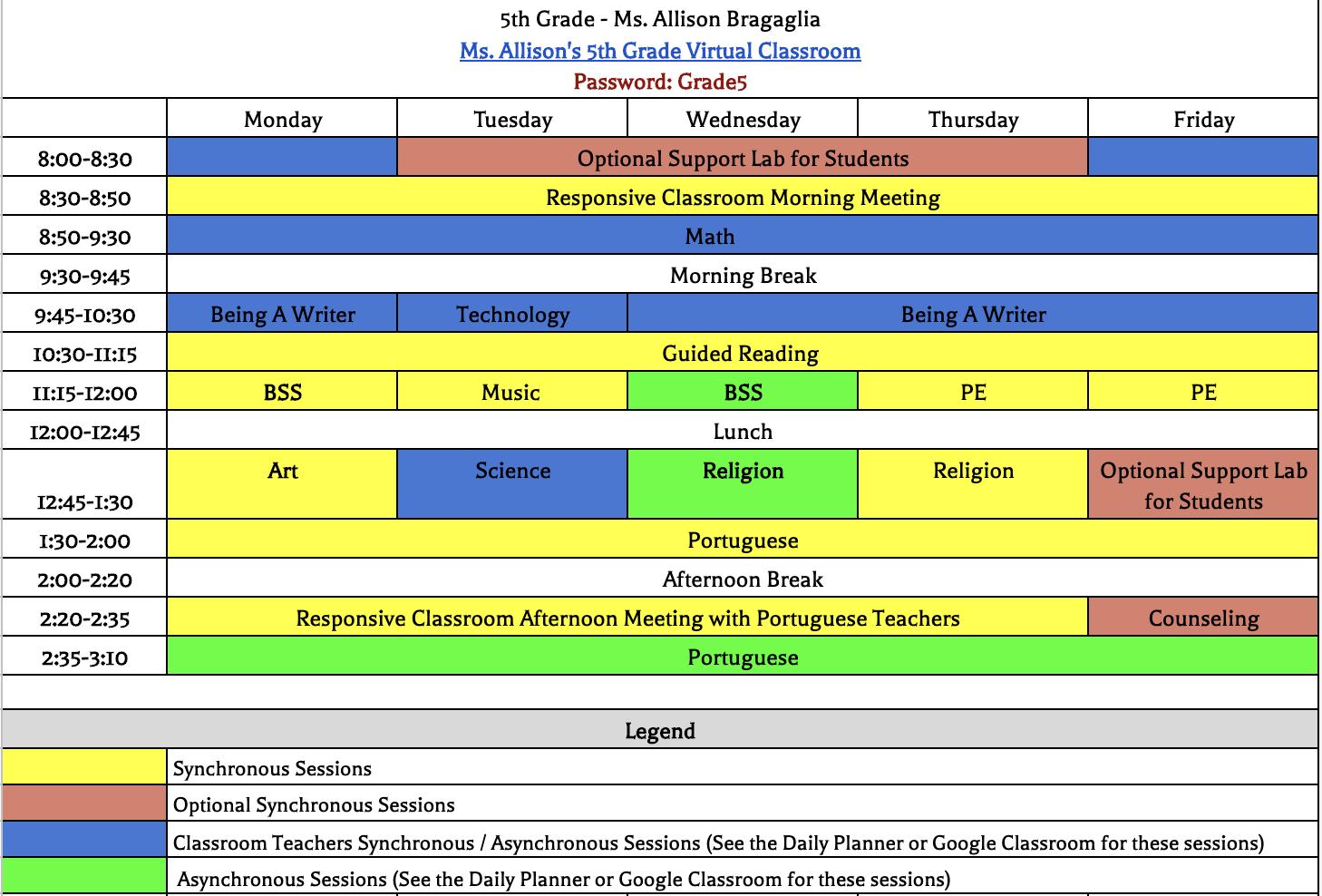
Video Conferencing/Live Sessions
(Synchronous Activities)
Video conferencing and live sessions ensure face-to-face time, social interaction, discussions, and consultation with teachers, to name a few. These sessions happen during the day and according to teachers/students' needs and requests. Sometimes they will be scheduled and structured and other times they will happen as necessary.
Students in 1st and 2nd grade will receive their announcements through the daily lesson planner and emails from the teacher. Students in 3rd to 6th grade must check Google Classroom every day and follow their regular class schedule.
For live sessions, security measures such as a password and a waiting room have been enabled, and students must use their real names and turn cameras on when joining a meeting. These measures are essential for creating and maintaining a safe and healthy learning environment.
“Zoom"/ “Google Meets” are tools to be used for educational purposes during school hours. Students should never share meeting links and passwords with anyone. Students should sign in to video conference sessions on time as if they were in class on campus. Students should find a comfortable and quiet place to work. Students should go to the bathroom before the session starts, and have their water bottles with them. Students should refrain from eating during sessions. For instructions, directions, and assignments: • Parents and students in 1st and 2nd grade should check the Daily Lesson Planner at 8 a.m. every day. • Students/ Parents in 3rd to 6th grade should check Google Classroom at 8 a.m. every day.
Procedures for Video Conferencing / Live Sessions
Live sessions follow the same procedures as a regular classroom, however, in a virtual setting. We kindly ask you to review these procedures with your child before joining a live session.
All students must be respectful of each other. All students must take turns in participating (listening and speaking). All students must listen to and follow teacher instructions. All students must dress appropriately for the session. All students must use their real names and turn cameras on when joining a meeting. All students must respect the teachers’ signal to mute and unmute microphones Students in 3rd-6th grade must use their Chapel Gmail account when joining video conferences.
Consequence for Inappropriate Online Behavior
Students will be guided and directed to comply with the expectations above, however, if after redirection the expectations are not met, the student may be removed from the conference during the class period. The teacher will schedule an individual conference with the student after class to process and reflect on online behavior.
Social-Emotional Learning
Besides Reading, Writing, Math, Portuguese and all specialist classes there is social-emotional learning and development that happens each day. Social-emotional learning is one of the curriculum pillars at Chapel. The Elementary School is based on the Responsive Classroom approach and the CARES (Cooperation, Assertion, Responsibility, Empathy, and Self-Control) standards. At our school, the social-emotional component is as important as academics. For this reason, we treasure Morning and Afternoon Meetings as a moment for students to connect and learn from each other, and to foster the sense of belonging to a group. As we are a screen away and in social isolation it’s essential that we keep our classroom community united and developing each day.
Responsive Classroom Morning Meetings
Classroom teachers and assistants host a Morning Meeting at 8:30 a.m. every school day (Monday through Friday). The whole class gathers in a “Zoom” video conference for this activity.
Objective: Morning Meetings happen at school every day and are part of our morning routine with students. We will continue to build our class community and the sense of belonging to a group while sharing our experiences during the Remote Learning season. During these meetings, teachers will also go over the agenda for the day and prepare students for their day. Meetings last around 15 minutes and can be extended according to each group and the topic being discussed.
Responsive Classroom Afternoon Meeting
Portuguese teachers and assistants host an Afternoon Meeting at 2:40 p.m. every school day (Monday through Friday). The whole class gathers in a “Zoom” video conference for this activity.
Objective: Portuguese teachers will use this time to check in on the Portuguese activities of the day and wrap up the day of Remote Learning. Additionally, these meetings will have a social-emotional component, similar to Morning Meetings.
Weekly Counselor Check-in
These check-ins happen once a week according to the class’ schedule and are optional.
Objective: During these sessions, counselors speak to students about how they are feeling, what they are missing, play collaborative games, talk to each other about the latest happenings, and current events to name a few. This is also a moment for counselors to identify students’ who need an individual session or emotional/ academic support.
Focus on Learning Plans and Child Study Team Meetings (CST)
If a teacher or a parent has a concern regarding a student’s achievement in any area of development, a Focus on Learning Plan is created by the classroom teacher based on assessment data and observations. A Child Study Team Meeting (CST) may be called if teachers or parents feel that a child needs additional strategies in place to assure academic or behavior success. The team includes parents, the student’s teacher(s), the principal, the Student Support Specialist, outside specialists (if applicable), and any other person whose feedback might be beneficial. The objective of such meetings is to gather information and devise an action plan to address the concerns.
The Student Support Office has staff that supports students and teachers. If a student is diagnosed with a learning disability, the Student Support Specialist may develop an Individual Educational Plan (IEP) for the student.
Individual Education Programming
Students who have an individual education program (IEP) will be fairly and accurately graded. The IEP, developed by the Child Study Team will determine if there are any standards that should be modified for an individual student. The IEP will define the modification of the standard(s), other learning goals, and list instructional strategies and adaptations needed. If any standard is modified, a goal page will be attached to the quarterly report card describing the student progress toward the goal.
This means that a team will determine if there is a standard that should be modified. The student will be graded to this “new” modified standard. The IEP will be attached to all quarterly report cards. If a standard is not modified, the student will be graded by the same criteria as all students in that grade.
Additionally, the IEP may indicate that teachers can/should accommodate assessments. This means that the teacher may assess a student orally while others are being assessed through writing, as long as the oral assessment is aligned to the same content standard. Again, effort or other non-standards based criteria will not influence the grade earned.
Parents who have a concern regarding their child must follow the Chapel Elementary/ ECEC Parent Communication Flow Chart on the following page.

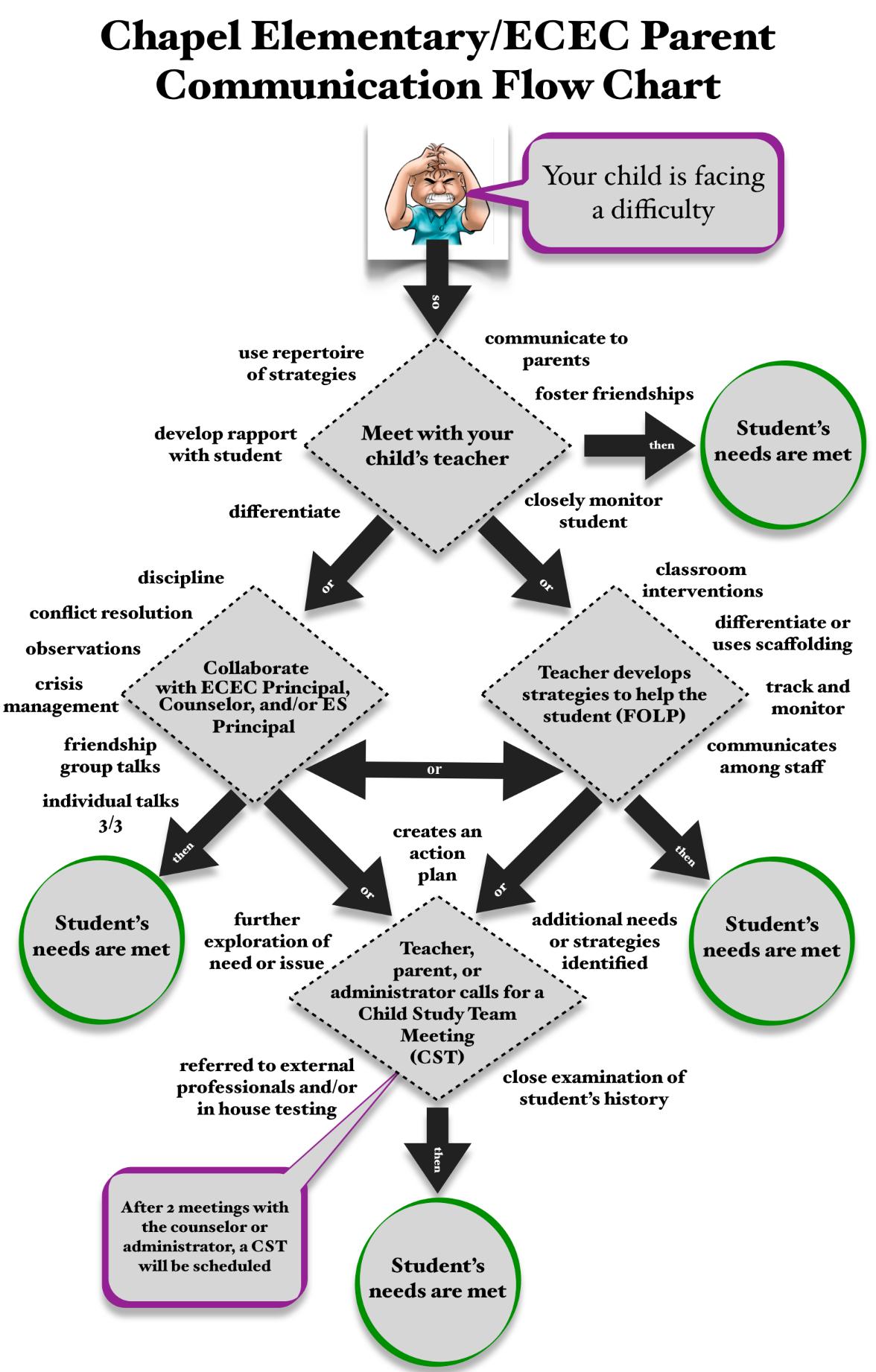
Elementary School Counselors
Our teachers and counselors observe individual students’ performance and offer individualized support. If you notice that your child needs some motivation and encouragement in regards to his Remote Learning, please don’t hesitate to communicate with them. They will promptly reply to your email and can schedule an individual conference with your child during school hours.
Lower Elementary School Counselor - Ms. Cris Cavalcanti (ccavalcanti@chapelschool.com) Upper Elementary School Counselor - Ms. Erika Ferreira (eferreira@chapelschool.com)
Attendance
Students are marked present at school if there’s evidence that they have been online during the school day, for example, they submitted their assignments to the classroom teacher, and/or they communicated with the teacher (parent/ teacher communication and/ or student/ teacher communication), and/or they attended a video conference session. All these are considered developmentally appropriate practices for our students in 1st through 6th grade.
Absences can be excused if they fall under the previous policies: illness with a doctor’s note, athletes' participation in official tournaments, and document appointments. All three possibilities must be registered, therefore, please continue to send documentation to the Elementary School Office. Please send an email to the classroom teacher if your child needs any support in completing the assignments after an absence.
Assessment Practices
The regular assessment practices at Chapel are based on formative and summative assessments. Formative assessments are used to demonstrate the learning related to each step of the learning process. They evaluate smaller pieces of content and are used to redirect instruction and also inform students about where they are in the learning process. Summative assessments are the final product of the learning and encompass all the previous steps.
The goal of formative assessment is to monitor student learning and to provide ongoing feedback that can be used by students. More specifically, formative assessments help students identify their strengths and challenges and target areas that need improvement and help teachers recognize where students are excelling and/or struggling and address learning accordingly.
For the Remote Learning season, the elementary school team has redesigned assessments to promote a multi-dimensional approach to learning, where students are encouraged to look at ideas in a variety of ways, looking for patterns, connections, and real-life applications. Media and digital tools are used to make students’ thinking and learning visible. Each daily assignment is considered a formative assessment and will be used to provide feedback to students as well as to project a summative grade at the end of each quarter.
It’s extremely important and essential that all students’ assignments are authentic and completed by the student. To assess students’ strengths and needs appropriately teachers’ must rely on the evidence/ assignments submitted. Therefore, to plan for students’ learning and development, closing learning gaps, and challenging students, all assignments must be a true and accurate reflection and production.
Assessment and Academic Testing
Chapel School uses multiple measures to determine what a student knows and is able to do in relation to our content standards, developmental benchmarks, and language acquisition. Assessment is ongoing and continuous.
Assessing Students
Students receive an electronic report card via PlusPortals each quarter. Teachers will assess student learning in various ways. Grades are based on multiple measures over time and refer to student mastery at that point in time.
Academic Grades
Grades reflect what students know and are able to do in relation to the curriculum standards. A student’s grades are a fair and accurate reflection of his or her performance.
Grading Scale
The following grading scale will be used in communicating students’ assignment scores and grades:
A score “Exceeds Expectations” (4) describes student performance which exceeds the expected grade level standard. A score "Meets Expectations” (3) describes student performance which meets the expected grade level standard. A score "Approaches Expectations” (2) describes student performance which approaches the expected grade level standard. A score “Needs Intervention" (1) describes student performance which falls far below the expected grade level standard and indicates a need for intervention. A score "No evidence of learning this quarter” (NE) describes student performance in which no evidence has been presented to teachers and indicates a need for intervention.
Issuing “No grade”
No final quarter grade will be issued based on the following criteria:
Student enrolled within three weeks of the end of a grading period The standard was not assessed during the grading period
Intervention
Intervention will be required for a student receiving a "Needs Intervention” (1) or "No evidence of learning this quarter” (NE) score on a report card. Examples of interventions are teacher-parent conference, Focus on Learning Plan, Child-Study Team meeting, or remediation.
Academic Dishonesty
Academic dishonesty includes cheating or copying the work of another student, plagiarism (presenting the work of others as his/her own), and unauthorized communication between students during an examination. The determination that a student has engaged in academic dishonesty shall be based on the judgment of the classroom teacher or supervising professional, taking into consideration written materials, observation, and/or information from students.
A student found to have engaged in academic dishonesty will have the assignment/ assessment score invalidated and shall be subject to disciplinary actions.
Conferences with Teachers
Parents may request a conference with teachers as necessary at any time throughout the Remote Learning season to discuss their child’s learning and development. Teachers and counselors are available to virtually meet with parents and students during regular school hours. Parents are encouraged to meet with their child’s teacher in case they have any questions, concerns, or would like to learn and share about their child’s accomplishments during this time.
Teachers’ Office Hours
Please don’t hesitate to contact your child’s teacher if you need any advice and/or guidance. Teachers will be available online for consultation with students and parents during school hours and according to the class schedule. The school day begins at 8 a.m. and ends at 3:10 p.m. every day. Teachers will be communicating with many families, therefore, we kindly ask parents to be objective and succinct when writing emails so that they can provide timely support to all families.
Weekly Communication with Parents
Every other week parents will receive an email from the Elementary School Principal Every Thursday, families will receive an email from the Elementary School Principal with a resource to an optional virtual activity for the family. Every Friday, parents will receive an email from the classroom teacher with a summary of the week’s accomplishments and a preview of the next week.
Technology Support
Please send an email to our Technology teacher Mr. Otavio Garcia (ogarcia@chapelschool.com), and he will be able to provide the support needed.


